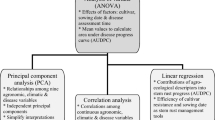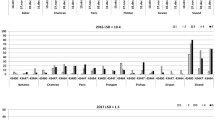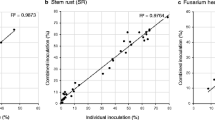Abstract
Stripe rust is a potential threat to wheat production in the world. From 2013 to 2017, a total number of 282 stripe rust progress curves were characterized at the plot scale in Kermanshah province, Iran, according to a number of agro-ecological traits. Disease incidence and severity varied by cultivar, planting date, sampling time and year. Area under disease progress curve (AUDPC) on a severity rating basis was ranked according to the Kruskal-Wallis one-way ANOVA. H-test comparisons among cultivars showed greater mean AUDPC values for cvs. Sivand, Bahar and Chamran II, while cv. Pishgam had a lowest AUDPC value. Mean AUDPC value for early disease onset was greater than that for late disease onset. Greater AUDPC corresponded to smaller resistance index ranging from 0 to 70. Highest and lowest AUDPC occurred in spring 2016 and 2015, respectively. From principal component analysis, three principal factors accounting for 84% of the total variance evidenced dependence of stripe rust development on air temperature and moisture, disease-onset and maturity date, resistance index, and planting date. From regression analysis, the number of days with minimum temperatures within the range of 5–12 °C and RH above 60%, disease-onset and maturity date, resistance index, and planting date accounted for 62% of variations in AUDPC values. The present findings emphasize careful selection of cultivar resistance, maturity and planting dates, along with climatic descriptors, to improve accuracy of disease prediction models, durability of cultivar resistance to stripe rust, and sustainability of disease management programs.


Similar content being viewed by others
References
Afzal, S. N., Haque, M. I., Ahmedani, M. S., Bashir, S., & Rattu, A. R. (2007). Assessment of yield losses caused by Puccinia striiformis triggering stripe rust in the most common wheat varieties. Pakistan Journal of Botany, 39, 2127–2134.
Anonymous (2016). Agricultural Production Report. Tehran, Iran: The Iranian Ministry of Agriculture. https://www.maj.ir. Accessed 14 January 2018.
Campbell, C. L., Madden, L. V., & Pennypacker, S. P. (1980). Structural characterization of bean root rot epidemics. Phytopathology, 70, 152–155.
Chen, X. M. (2005). Epidemiology and control of stripe rust Puccinia striiformis f. Sp. tritici on wheat. Canadian Journal of Plant Pathology, 27, 314–337.
Coakley, S. M., Line, R. F., & McDaniel, L. R. (1988). Predicting stripe rust severity on winter wheat using an improved method for analyzing meteorological and rust data. Phytopathology, 78, 543–550.
de Vallavieille-Pope, C., Huber, L., Leconte, M., & Goyeau, H. (1995). Comparative effects of temperature and interrupted wet periods on germination, penetration, and infection of Puccinia recondita f. Sp. tritici and P. striiformis on wheat seedlings. Phytopathology, 85, 409–415.
Gladders, P., Langton, S. D., Barrie, I. A., Hardwick, N. V., Taylor, M. C., & Paveley, N. D. (2007). The importance of weather and agronomic factors for the overwinter survival of yellow rust (Puccinia striiformis) and subsequent disease risk in commercial wheat crops in England. Annals of Applied Biology, 150, 371–382.
Huet, P. (1986). Influence du système de culture sur le piétin verse du blé. In Les Rotations Céréalières Intensives: Dix Années D’études Concertées (pp. 95–111). Paris, France: INRA.
Jeger, M. J. (2004). Analysis of disease progress as a basis for evaluating disease management practices. Annual Review of Phytopathology, 42, 61–82.
Kranz, J. (1974). Comparison of epidemics. Annual Review of Phytopathology, 12, 355–374.
Large, E. C. (1954). Growth stages in cereals. Plant Pathology, 3, 128–129.
Loyce, C., Meynard, J. M., Bouchard, C., Rolland, B., Lonnet, P., Bataillon, P., Bernicot, M. H., Bonnefoy, M., Charrier, X., Debotej, B., Demarquet, T., Duperrier, B., Félix, I., Heddadj, D., Leblanc, O., Leleu, M., Mangin, P., Méausoone, M., & Doussinault, G. (2008). Interaction between cultivar and crop management effects on winter wheat diseases, lodging, and yield. Crop Protection, 27, 1131–1142.
Ma, H., & Singh, R. P. (1996). Contribution of adult plant resistance gene Yr18 in protecting wheat from yellow rust. Plant Disease, 80, 66–69.
Madden, L. V., & Nutter, F. W., Jr. (1995). Modeling crop loss at the field scale. Canadian Journal of Plant Pathology, 17, 124–137.
Moschini, R. C., & Pérez, B. A. (1999). Predicting wheat leaf rust severity using planting date, genetic resistance, and weather variables. Plant Disease, 83, 381–384.
Pineiro, G., Parelman, S., Guerschman, J. P., & Paruelo, J. M. (2008). How to evaluate models: Observed vs. predicted or predicted vs. observed? Ecological Modeling, 216, 316–322.
Rapilly, F. (1979). Yellow rust epidemiology. Annual Review of Phytopathology, 17, 59–73.
Sharma, S. (1996). Applied multivariate techniques. New York, USA: Wiley.
Sharma-Poudyal, D., & Chen, X. M. (2011). Models for predicting potential yield loss of wheat caused by stripe rust in the U.S. Pacific northwest. Phytopathology, 101, 544–554.
Sharma-Poudyal, D., Chen, X. M., & Rupp, R. (2014). Potential oversummering and overwintering regions for the wheat stripe rust pathogen in the contiguous United States. International Journal of Biometeorology, 58, 987–997.
Shaw, M. W., & Royle, D. J. (1993). Factors determining the severity of epidemics of Mycosphaerella graminicola (Septoria tritici) on winter wheat in the UK. Plant Pathology, 151, 882–899.
Stubbs, R. W. (1985). Stripe rust. In A. P. Roelfs & W. R. Bushnell (Eds.), The cereal rusts II. Diseases, distribution, epidemiology and control (pp. 61–101). New York, USA: Academic Press.
Wan, A. M., Chen, A. D. X. M., & He, Z. H. (2007). Wheat stripe rust in China. Australian Journal of Agricultural Research, 58, 605–619.
Zeng, S. M. (2004). Simulation study on cultivar deployment against wheat stripe rust caused by Puccinia striiformis west. In China. Acta Phytopathologica Sinica, 34, 261–271.
Acknowledgements
This research was financially supported by the Iranian Agricultural Research, Education & Extension Organization, project no. 2-55-16-94165. The authors acknowledge Mr. M Noroozi for his technical assistance throughout this work.
Author information
Authors and Affiliations
Corresponding author
Ethics declarations
Conflict of interest
There is no conflict of interest related to this research.
Research involving human participants and/or animals
This is not applicable to this research.
Informed consent
This is not applicable to this research.
Additional information
Publisher’s note
Springer Nature remains neutral with regard to jurisdictional claims in published maps and institutional affiliations.
Rights and permissions
About this article
Cite this article
Naseri, B., Marefat, A. Wheat stripe rust epidemics in interaction with climate, genotype and planting date. Eur J Plant Pathol 154, 1077–1089 (2019). https://doi.org/10.1007/s10658-019-01729-8
Accepted:
Published:
Issue Date:
DOI: https://doi.org/10.1007/s10658-019-01729-8




